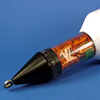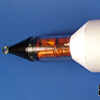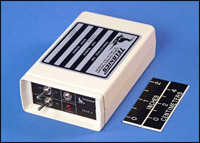GPS/Argos Systems for Manatee and Dugong

TMT-462-3 GPS/Argos System for use on manatee and dugong.
Models
| Model |
Dimensions L x D (in, cm) |
Weight (g) |
Operational Life (days)
Scenario 1 |
Operational Life (days)
Scenario 2 |
Operational Life (days)
Scenario 3 |
| TMT-462-3 |
24.5 x 5.5
62.2 x 14.0 |
2165 |
231 |
412 |
203 |
| TMT-464-3 |
20.75 x 4.25
52.7 x 10.8 |
1250 |
243 |
393 |
198 |
Estimates of operational life above are provided in days as calculated by TPP and assume Argos transmissions scheduled 24-hours/day, 31-byte transmission, 60 second repetition rate, use of satellite predictions on unit, 500-mW power, VHF 24-hours/day, and 25°C.
Differences between the scenarios are:
Scenario 1: GPS collected hourly, unit continually on surface (Salt-water-switch out of water)
Scenario 2: GPS collected hourly, unit underwater 50% of time
Scenario 3: GPS collected every 15 minutes, unit underwater 50% of time.
Note that the despite their differences in size and that different power supplies are used, these configurations have similar battery capacity. With the TMT-462-3 the VHF power supply is distinct from the GPS/Argos, and it provides ~18 months life if operating continuously at 60 bpm (daily or seasonal duty-cycling can extend this life). With the TMT-464-3, the VHF and GPS/Argos operate off the same power supply until the main power supply begins to exhaust, at which time the VHF switches to a secondary battery pack which provides the VHF transmitter power for ~1 year to facilitate recovery of the tag.
Key Features
- These units are designed to be tethered to the caudal peduncle of sirenians. The tether is not included and must be provided by the user. The electronics and power supply are contained in an sealed housing with a flotation collar. The housing design allows the user to replace the battery packs. Battery packs are included in the purchase price but replacement packs must be purchased separately.
- The GPS antenna is within the housing, and the external whip antenna is used for both Argos and VHF transmissions.
- The Argos system provides global coverage. On-board satellite overpass predictions allow efficient data transfer, with units able to be programmed to transmit only to specific satellites and only when the satellites are predicted to be in view.
- These units are typically programmed to collect GPS positions when adequate surfacing time allows, and Quick Fix Pseudoranging (QFP) positions in as little as 3 seconds when reduced surface time prevents a standard GPS position from being obtained.
- Salt-water-switch (SWS) synchronizes GPS attempts and Argos transmissions with surfacings to maximize data collection and transmission, and suppresses Argos transmissions and GPS attempts while under water to extend operational life. The SWS also allows collection of dive data including length of dives, dive count, and percentage of time spent under water. The SWS settings can be selected to allow detection of either seawater, or most freshwater and seawater (submergence may not be able to be detected in water with very low conductivity).
- Argos transmissions can be duty-cycled (e.g. daily and seasonal cycles), and the number of Argos transmissions in a defined interval can also be limited (e.g. not more than 100 within 6 hours), to extend operational life.
- Temperature sensing is available.
- All positions determined and sensor data collected is stored-on-board the unit, thus if the tag is able to be recovered, stored data can supplement what was transmitted.
- A real-time clock and calendar controls all timing functions and is re-synchronized with GPS time to assure high accuracy timing. All timing is programmed using Coordinated Universal Time (UTC).
- These models can be programmed using Telonics Product Programmer (TPP). TPP makes it possible for users to program their own systems and simulate performance of the system prior to deployment.
- On-board sensors can be activated or deactivated. Data collection regimes and schedules can be altered. Sensor data can be added or deleted from Argos transmissions.
- Argos ID codes, transmission frequencies, transmission power levels, and transmission schedules can all be modified.
- Data retrieved through Argos are processed using the Telonics Data Converter (TDC). TDC provides complete data decoding of Argos DS files, including location and sensor data, and provides for plotting of locations in Google Earth.
- Standard output power is 500mW; a lower power option (400mW) is also available. Units are powered by primary battery. They are turned on or off using a magnetic switch. When off, these units consume less than 12 µA.
Electronic Specifications
µGPSI-23 GPS/Argos/VHF Specifications - Show
General Specifications
| Timing Accuracy |
Timing is synchronized to GPS time when available. If GPS time is not available, then internal timing accuracy is:
6 min/year at 25° C
30 min/yr -20 to +40° C
47 min/yr -40 to +70° C |
| Available Sensors |
Mortality, Activity, Temperature, Low Voltage (as allowed by specific software)
Salt-water-switch and Pressure are hardware and software options on some configurations. |
| Memory Capacity |
Capable of storing ~500K fixes in nonvolatile flash memory in association with other sensor data. |
| Programming |
Programmable using Telonics TPP software and TSC-9A cable. Programming options are hardware and software dependent, but include GPS, Argos, and VHF schedules; sensor activation and schedules; power output; Argos can also be scheduled to transmit only during satellite overpasses based on the GPS location and the orbital parameters installed prior to deployment. |
GPS Receiver Specifications
| Performance |
-163 dBm tracking sensitivity
-147 dBm acquisition sensitivity |
| Datum |
WGS-84 |
| Time to First Fix (TTFF) |
35 sec typical (with clear view of sky)
Quick Fix Pseudoranging (QFP) 3-5 sec typical (with clear view of sky) |
Argos Transmitter Specifications
| Operating Frequency |
ARGOS Frequencies
401.6300MHz to 401.6800MHz in 1 kHz Steps
Brazilian SCD-1, Channels C1 to C9
401.6180MHz to 401.6220MHz in 500Hz Steps |
| Frequency Stability |
± 0.5 ppm maximum from -30° to +70° C
± 2.0 ppm maximum from -40° to -30° C |
| Initial Frequency Error |
± 0.5 ppm maximum at +23°C, ± 2° C |
| Aging |
± 2.0 ppm maximum after 1 year |
| RF Power Out |
Standard Power version: 500mW (+27dBm), 400mW (+26dBm) option, into 50 Ω
(User selectable using TPP programming software)
High Power version (H): 800 mW (+29 dBm) ±1dB nominal into 50 Ω
(available in some configurations) |
| Spurs and Harmonics |
<-40dBc minimum, -60dBc typical (Coherent Spurious)
<-50dBc minimum, -60dBc typical (Non-coherent spurious) |
VHF Transmitter Specifications
| Available Frequency Options |
Option 702 134-139 MH
Option 705 140-154 MH
Option 707 146-160 MH
Option 715 156-172 MH
Option 720 160-177 MH
Option 740 174-192 MH
Option 750 191-210 MH
Option 760 210-237 MH
Note: Frequency can be programmed in 100Hz steps within a given frequency range. |
| Frequency Stability |
Better than ±3ppm at room temperature ±5 ppm total tolerance over full temperature range |
| Operating Temperature |
-40° to +70° C |
| Pulse Width |
Programmable (10 to 250 msec) |
| Pulse Period |
Programmable (265 to 5000 msec)
Multiple pulse periods selectable per specific software and TPP |
| Transmitter Timing |
Programmable, including daily and seasonal duty cycles. |
| Power Output |
Selectable levels via hardware and software.
Effective Isotropic Radiated Power (EIRP) varies, depending on packaging, antenna configuration, and immediate environmental conditions. *California Users: This transmitter meets the California requirement of EIRP < 0.0009W for all configurations. |
| Emission Designator |
2k00P0N |
| Harmonic Suppression |
Better than 30dB (>40 dB typical) |
| Spurious Emissions |
<-35 dBc at 10 kHz offset from carrier |
| Frequency |
Aging: <2ppm/year
Shock: <1ppm 3000g x 0.3ms x ½ sine x 3 dir |
| VSWR |
RF output stable to 10:1 VSWR, all phases
Radiated harmonic levels are degraded with poor load VSWR.
Spurious emission specification maintained for >10:1 VSWR |
Photo Gallery
Related Products
Related Links to Information on Other Websites
Legacy Products
This information on discontinued products is provided for individuals who are still using these older systems. Product descriptions may be time sensitive or even outdated. Please contact Telonics if you have questions.
Telonics supports these products as possible based on availability of parts, software, or other considerations; but no longer sells them new.
Legacy: TMT-462 Specifications (Uses the µGPSI-20 System) Show
General System Specifications
| Timing Accuracy |
Timing is synchronized to GPS time when available. If the GPS time is not then internal
timing accuracy is:
6 min/year at 25° C
30 min/yr -20 to +40° C
47 min/yr -40 to +70° C
|
| Available Sensors |
Mortality, Activity, Temperature, Low Voltage |
| Memory Capacity |
Capable of storing 100K fixes in nonvolatile flash memory in association with other sensor data. |
| Argos Transmissions |
System can be operated in a mode where unit transmits only during satellite overpasses based on the GPS location and the orbital parameters installed prior to deployment. (GPS-Argos systems only). |
GPS Receiver Specifications
| Standby Current |
0µA |
| Performance |
12 channels
-156 dBm tracking sensitivity
-142 dBm acquisition sensitivity
|
| Datum |
WGS-84 |
| Time to First Fix (TTFF) |
40sec typical (with clear view of sky)
Quick Fix Pseudoranging (QFP) 7sec typical (with clear view of sky)
|
uGPSI-20 Argos Certified Transmitter Specifications
| RF Output Impedance |
50 Ω |
| Operating Frequency |
ARGOS Frequencies
401.6300MHz to 401.6800MHz in 1 kHz Steps
Brazilian SCD-1, Channels C1 to C9
401.6180MHz to 401.6220MHz in 500Hz Steps
|
| Frequency Stability |
+/- 0.5 ppm maximum from -30° to +70° C
+/- 2.0 ppm maximum from -40° to -30° C
|
| Initial Frequency Error |
+/- 0.5 ppm maximum at +23°C, +/- 2° C |
| Aging |
+/- 2.0 ppm maximum after 1 year |
| RF Power Out |
Standard Power Version:
400mW (+26dBm) or 500mW (+27dBm) nominal into 50 Ω
(User selectable using TPP programming software)
High Power version (H):
800 mW (+29 dBm) ±1dB nominal into 50 Ω
Note 1: At +70°C, transmit current will increase by approximately 10% from the +25° C measurement. Conversely, at -40° C it will decrease by approximately 10% from the +25° C measurement.
Note 2: Transmit current and RF power out are sensitive to VSWR. Both can be degraded significantly if the antenna or antenna coax are of poor quality or not correctly tuned and matched to the ARGOS/Brazilian frequency band 50 ohm RF output impedance.
|
| Spurs and Harmonics |
<-40dBc minimum, -60dBc typical (Coherent Spurious)
<-50dBc minimum, -60dBc typical (Non-coherent spurious)
|
TMT-462 VHF Transmitter Component Specifications
| Available Frequency Options |
Option 705 140-154 MHz
Option 707 146-160 MHz
Option 715 156-172 MHz
Option 720 160-177 MHz
Option 740 174-192 MHz
Option 750 191-210 MHz
Option 760 210-237 MHz
Note: The frequency can be programmed in 100Hz steps within a given frequency range.
|
| Frequency Stability |
Better than ±3ppm at room temperature ±5 ppm total tolerance over full temperature range |
| Operating Temperature |
-40° to + 70° C |
| Pulse Width |
Programmable (10 to 250 msec) |
| Pulse Period |
Programmable (560 to 5000 msec)
3 separate pulse period values selectable:
Period 1 (indicates last GPS fix successful)
Period 2 (indicates last GPS fix unsuccessful)
Inactive period (if no motion for selected time)
|
| Available Sensors |
Mortality Sensor (parameters are user programmable) |
| Transmitter Timing |
Programmable seasons and duty cycles. |
| Power Output |
Programmable Low/Medium/High Effective Isotropic Radiated Power
(EIRP) varies, depending on packaging, antenna configuration, and immediate environmental conditions.
* California Users: This transmitter meets the California requirement of EIRP < 0.0009W for all configurations.
|
| Emission Designator |
2k00P0N |
| Harmonic Suppression |
Better than 30dB (>40 dB typical) |
| Spurious Emissions |
<-35 dBc at 10 kHz offset from carrier |
| Frequency |
Aging: <2ppm/yr
Shock: <1ppm 3000g x 0.3ms x ½ sine x 3 dir
|
| VSWR |
RF output stable to 10:1 VSWR, all phases
Radiated harmonic levels are degraded with poor load VSWR.
Spurious emission specification maintained for >10:1 VSWR
|
| Programming |
Transmitter parameters programmable via antenna "1-pin" interface and Telonics TPP software. |
| TMT-462 Packing/Housing Specifications |
Designed for application on sirenians. Units are contained in an O ring sealed housing which includes a flotation collar. Housing includes an eye-bolt mounted the nose cone which allows for attachment of a tether from the electronics to the study animal. Salt water switches are built in to the housing to allow the unit to detect diving behavior. The GPS antenna is integrated into the housing for protection. The external whip antenna system allows both ARGOS and VHF signals to be transmitted for data recovery and tracking purposes. |
Lithium Battery Shipping Regulations
Telonics Inc. ships all systems containing lithium batteries in accordance with the US Department of Transportation rules for hazardous materials set forth in 49CFR and the IATA Dangerous Goods Regulations.
Shipping dangerous goods can be complicated and confusing, consult a dangerous goods specialist if needed. The general requirements for shipping lithium batteries according to 49CFR are located in Part 173, Subpart 173.185 in the link below.
http://www.ecfr.gov/cgi-bin/text-idx?SID=e8334217c2c8d081457a5156872ad037&tpl=/ecfrbrowse/Title49/49cfrv2_02.tpl#0
Service Commitment
Since 1970, Telonics has built a reputation based on product quality, product support, service, and customer satisfaction. Telonics strives to produce the highest quality products, and to support those products accordingly.
Because of extreme conditions and the unpredictable nature associated with most telemetry applications, problems occasionally arise. Most problems can be resolved quickly. In all cases, we hope to be able to work in partnership with users to resolve problems to the user's satisfaction and to uphold our demonstrated commitment to excellence. If problems should arise, all products must be returned to our factory for failure analysis.
Warranty: GEN 4 GPS Systems - Show
Telonics warrants its GPS products to be free from defects in material and workmanship for a period of one year from the date acquired. Telonics does not warrant batteries.
Telonics designs and manufactures systems for a variety of applications using several satellite systems (GPS, Argos, Iridium, and Globalstar). At the time of manufacturing, Telonics equipment is tested to verify compatibility with the applicable satellite system(s). Telonics does not warranty equipment against changes in satellite system specifications or satellite operation after the date your equipment was manufactured. Unforeseeable or unplanned system changes would include, but are not limited to, elevated ambient noise levels in the radio frequency bands used for satellite communications, elimination of service in a region of the world, data outages due to technical problems within the satellite system network, or reductions in data transfer capability due to alterations in the constellation as a result of premature space vehicle failures or failure to replace space vehicles in a timely manner.
If a defect occurs, return the equipment to us within the proper time frame at the following address: TELONICS, 932 E. IMPALA AVENUE, MESA AZ USA 85204-6699. The customer shall arrange for and pay all shipping, insurance and related charges incurred in the shipment to and from Telonics under this warranty. Damage to any equipment resulting from misuse, accidents, unauthorized service, extreme conditions, or other causes, is excluded from this warranty. Telonics does not assume responsibility for loss or damage to equipment during shipment. Telonics does not assume responsibility for delays resulting from shipment on commercial or private carriers. We insure all equipment shipped from our facility and suggest that shipments to Telonics also be insured.
Upon the timely return to our facility, if defective, the product will be replaced or repaired at our discretion at no cost to the customer. This remedy is the exclusive remedy. This product is supplied without any further warranties or conditions, expressed or implied, including warranties of merchantability, quality or fitness for particular reason or those arising by laws, statutes or trade usage or course of dealing.
The entire risk, as to the results and performance of the product, is assumed by the customer. Neither Telonics, nor its suppliers, shall have any liability to the customer or any other person or entity for any indirect, incidental, special, or consequential damage whatsoever, regardless whether Telonics has been told of the possibility of such damages or that such damages might be foreseeable. Telonics has no responsibility or liability for the claims of any third party. The maximum aggregate to the customer, of Telonics and its suppliers, shall not exceed the amount paid by the customer for the product.









